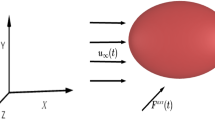Summary
To study the motion of an arbitrary near sphere immersed in a homogeneous shear flow of an incompressible viscoelastic fluid we impose the restriction that the flow is dynamically and rheologically slow. This allows us to derive an expression for the hydrodynamic force and couple, respectively, which are exerted upon the particle. With the exception of elongational flows marked differences to the behavior in a newtonian fluid show up: sedimentation in a quiescent fluid is accompanied by a rotation until a stable terminal orientation is attained. For prolate spheroids the symmetry axis thus ends up parallel to the direction of the external force and perpendicular to it if the spheroid is oblate. In simple shear the difference between prolate and oblate spheroids manifests itself in the direction in which the rotating symmetry axis drifts (orbit-drift): prolate spheroids drift towards the orbitC = 0 while for oblate ones the drift is towardsC = 0. For deviations from the spheroidal shape (but still fore-aft symmetry) another orbitC * comes into play. Some particles drift towardsC * while others towardsC = 0 if initiallyC < C * and towardsC = ∞ if initiallyC > C *. If no longer matters whether the particle is slender or not. Although this is perhaps the most interesting result obtained one should also mention the behavior of an ovoid in simple shear. If the symmetry axis is parallel to the vorticity vector the resulting translational slip velocity causes the particle to migrate out of the flow-shear plane in the direction of its pointed end.
Zusammenfassung
Um die Bewegung eines nahezu kugelförmigen Teilchens, das sich in einer homogenen Scherströmung einer viskoelastischen Flüssigkeit befindet, theoretisch erfassen zu können, beschränken wir uns auf dynamisch und rheologisch langsame Strömungen. Das ermöglicht uns, Ausdrücke für die hydrodynamische Kraft und das Drehmoment zu berechnen. Mit Ausnahme von Dehnströmungen ergeben sich daraus fundamentale Unterschiede gegenüber dem Verhalten in einer newtonschen Flüssigkeit. So wird die Sedimentation in einer ruhenden Flüssigkeit von einer Rotation begleitet, die das Teilchen in eine stabile Endlage bringt. Bei länglichen Rotationsellipsoiden bedeutet dies, daß sich die Symmetrieachse parallel zur Richtung der äußeren Kraft einstellt, bei abgeplatteten dagegen senkrecht dazu. Ähnliche Unterschiede treten in der einfachen Scherströmung auf. So driftet die Symmetrieachse länglicher Rotationsellipsoide in den OrbitC = 0, währendC = ∞ der Endorbit für abgeplattete Rotationsellipsoide ist. Sind dagegen Abweichungen von dieser Körpergestalt vorhanden, wobei aber immer noch Spiegelsymmetrie vorliegt, so tritt ein anderer ausgezeichneter OrbitC * auf. Die Symmetrieachsen einiger Teilchen driften in diesen Orbit, während andere in den OrbitC = 0 wandern, wenn anfänglichC < C * war, und in den OrbitC = ∞, wenn anfänglichC > C * war. Dabei spielt es keine Rolle, ob das Teilchen länglich oder abgeplattet ist. Dies ist wahrscheinlich das interessanteste Resultat, obwohl auch das Verhalten eines Ovoids in der gleichen Strömung Beachtung verdient; Steht die Symmetrieachse senkrecht zur Strömungsscherebene, so zieht die translatorische Gleitungsgeschwindigkeit eine Bewegung aus dieser Ebene in Richtung des spitzen Endes nach sich.
Similar content being viewed by others
References
Brenner, H., Chem. Engng. Sci.19, 519, 631 (1964).
Brunn, P., Rheol. Acta15, 104 (1976).
Brunn, P., Rheol. Acta15, 163 (1976);16, 324 (1977).
Brunn, P., Rheol. Acta16, 461 (1977).
Brunn, P., J. Fluid Mech.82 (3), 529 (1977).
Caswell, B., to be published.
Gauthier, F., H. L. Goldsmith, S. G. Mason, Rheol. Acta10, 344 (1971).
Karnis, A., S. G. Mason, Trans. Soc. Rheol.10, 571 (1967).
Leal, L. G., J. Fluid Mech.69, 309 (1975).
Author information
Authors and Affiliations
Additional information
With 4 figures and 1 table
Rights and permissions
About this article
Cite this article
Brunn, P. The motion of a slightly deformed sphere in a viscoelastic fluid. Rheol Acta 18, 229–243 (1979). https://doi.org/10.1007/BF01542770
Received:
Issue Date:
DOI: https://doi.org/10.1007/BF01542770




